Ken Binmore
Game Theory
A Very Short Introduction
Contents
List of illustrations xiii |
| The name of the game |
| Chance |
| Time |
| Conventions |
| Reciprocity |
| Information |
| Auctions |
| Evolutionary biology |
| Bargaining and coalitions |
Puzzles and paradoxes |
References and further reading |
Index |
List ofillustrations
1 Matching Pennies
2 Payofftables
3 Numerical payoffs
4 Games with mixed motivations
5 James Dean
6 John Nash
7 Two versions of the Prisoners Dilemma
8 Rolling dice
9 Learning to play an equilibrium
10 Twoboard games
11 Kidnap
12 Cosy Kidnap
13 Ultimatum Minigame
14 Evolutionary adjustment in the Ultimatum Minigame
15 Simplified Chain Store paradox
16 David Hume
17 Schellings Solitaire
18 Stag Hunt Game
19 Reciprocal grooming by chimps
20 Thefolk theorem
21 Information sets for Matching Pennies
22 Full house
23 Maximin play inVon Neumanns Poker model
24 Von Neumannsmodel
25 Payoff table forVon Neumanns Poker model
26 Incompleteinformation in Chicken
27 The Judgement ofSolomon
28 Going, Going,Gone!
29 Replicatordynamics in the Hawk-Dove Game
30 Relatives playthe Prisoners Dilemma
31 Vampire bat
32 Hawk-Dove-Retaliator Game
33 The Nashbargaining solution
34 Transparentdisposition fallacy
35 Two attempts tosatisfy Newcombs requirements
36 Three midwesternladies
37 Monty Hall Game
Chapter 1
The nameof the game
What is gametheory about?
When my wifewas away for the day at a pleasant little conference in Tuscany, three youngwomen invited me to share their table for lunch. As I sat down, one of themsaid in a sultry voice, Teach us how to play the game of love, but it turnedout that all they wanted was advice on how to manage Italian boyfriends. Istill think they were wrong to reject my strategic recommendations, but theywere right on the nail in taking for granted that courting is one of the manydifferent kinds of game we play in real life.
Driversmanoeuvring in heavy traffic are playing a driving game. Bargain-huntersbidding on eBay are playing an auctioning game. A firm and a union negotiatingnext years wage are playing a bargaining game. When opposing candidates choosetheir platform in an election, they are playing a political game. The owner ofa grocery store deciding todays price for corn flakes is playing an economicgame. In brief, a game is being played whenever human beings interact.
Antony andCleopatra played the courting game on a grand scale. Bill Gates made himselfimmensely rich by playing the computer software game. Adolf Hitler and JosefStalin played a game that killed off a substantial fraction of the worldspopulation. Kruschev and Kennedy played a game duringthe Cuban missile crisis that might have wiped us out altogether.
With such a wide field ofapplication, game theory would be a universal panacea if it could alwayspredict how people will play the many games of which social life largelyconsists. But game theory isnt able to solve all of the worlds problems,because it only works when people play games rationally. So it cantpredict the behaviour of love-sick teenagers like Romeo or Juliet, or madmenlike Hitler or Stalin. However, people dont always behave irrationally, and soit isnt a waste of time to study what happens when people put on theirthinking caps. Most of us at least try to spend our money sensibly and wedont do too badly much of the time or economic theory wouldnt work at all.
Even when people haventthought everything out in advance, it doesnt follow that they are necessarilybehaving irrationally. Game theory has had some notable successes in explainingthe behaviour of spiders and fish, neither of which can be said to think atall. Such mindless animals end up behaving as though they were rational,because rivals whose genes programmed them to behave irrationally are nowextinct. Similarly, companies arent always run by great intellects, but themarket is often just as ruthless as Nature in eliminating the unfit from thescene.
Does game theory work?
In spite of itstheoretical successes, practical men of business used to dismiss game theory asjust one more ineffectual branch of social science, but they changed theirminds more or less overnight after the American government decided to auctionoff the right to use various radio frequencies for use with cellular telephones.
With no establishedexperts to get in the way, the advice of game theorists proved decisive indetermining the design of the rules of the auctioning games that were used. Theresult was that the
American taxpayer made aprofit of $20 billion more than twice the orthodox prediction. Even more wasmade in a later British telecom auction for which I was responsible. We made atotal of $35 billion in just one auction. In consequence, Newsweek magazinedescribed me as the ruthless, Poker-playing economist who destroyed the telecomindustry!
As it turned out, thetelecom industry wasnt destroyed. Nor is it at all ruthless to make the fatcats of the telecom industry pay for their licences what they think they areworth especially when the money is spent on hospitals for those who cantafford private medical care. As for Poker, it is at least 20 years since Iplayed for more than nickels and dimes. The only thing that Newsweek gotright is that game theory really does work when applied by people who know whatthey are doing. It works not just in economics, but also in evolutionarybiology and political science. In my recent book Natural Justice, I evenoutrage orthodox moral philosophers by using game theory when talking aboutethics.
Toy games
Each new big-money telecomauction needs to be tailored to the circumstances in which it is going to berun. One cant just take a design off the shelf, as the American governmentfound when it hired Sothebys to auction off a bunch of satellite transponders.But nor can one capture all the complicated ins and outs of a new telecommarket in a mathematical model. Designing a telecom auction is therefore asmuch an art as a science. One extrapolates from simple models chosen to mimicwhat seem to be the essential strategic features of a problem.
I try to do the same inthis book, which therefore contains no algebra and a minimum of technicaljargon. It looks only at toy games, leaving aside all the bells and whistleswith which they are complicated in real life. However, most people find thateven toy games give them plenty to think about.
-1.jpg)
1. Alice and Bobsdecision problem in Matching Pennies
Conflict and cooperation
Most of the games in thisbook have only two players, called Alice and Bob. Thefirst game they will play is Matching Pennies.
Sherlock Holmes and theevil Professor Moriarty played Matching Pennies on the way to their finalconfrontation at the Reichenbach Falls. Holmes had to decide at which stationto get off a train. Moriarty had to decide at which station to lie in wait. Areal-life counterpart is played by dishonest accountants and their auditors.The former decide when to cheat and the latter decide when to inspect thebooks.
In our toy version, Aliceand Bob each show a coin. Alice wins if both coins show the same face. Bob winsif they show different faces. Alice and Bob therefore each have two strategies,
Next page
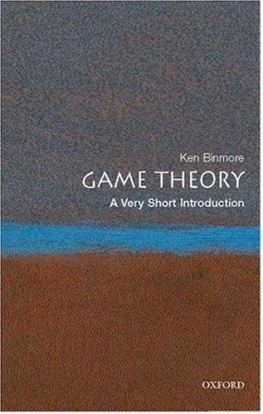

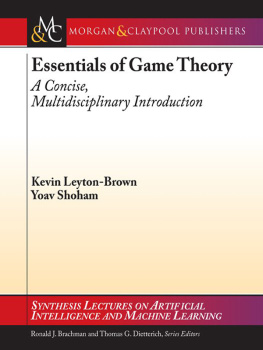
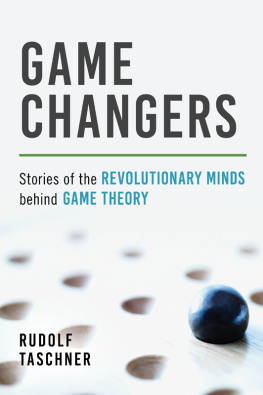
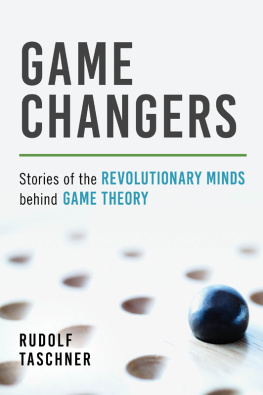
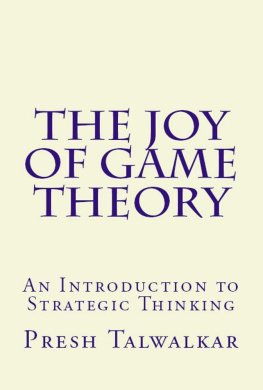
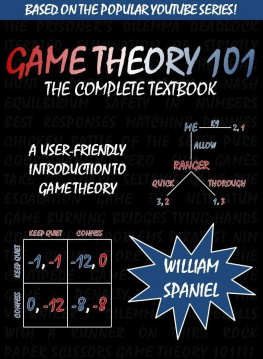

-1.jpg)